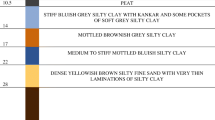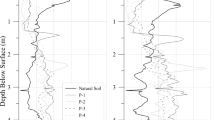Abstract
Soil creep is mostly manifested in slow-moving landslides. It is often the case for active slow-moving landslide with slip zone comprising clayey soil where creep would develop in the residual condition. If gravel is presented in clayey soil, this will have considerable impact on creep behavior of clayey soil. However, knowledge about creep behavior of the clayey soil containing gravel particles is scarce. This paper discusses creep behavior of natural clayey soil with gravel at residual state through a series of creep shear tests. Soil samples for this testing program were collected from the slip zones of two large slow-moving landslides in China. The collected soil samples consisted of clayey soil containing various amounts of gravel particles. The test results show that the soil specimens underwent two different creep patterns. An attenuating creep pattern was observed when the soil specimens were subjected to creep stress less than the residual strength, and a creep with increasing strain rate, or a nonattenuating creep pattern, with no evident secondary creep was noted when creep stress was intestinally increased to a level slightly greater than the residual strength. The creep patterns of clayey soil with gravel at the residual state observed in this study were noted to be very consistent with those of the gravel-free clayey soil reported in Bhat et al. (Int J Geomater 1(1):39–43, 2011, Nat Hazards 69(3):2161–2178, 2013) and Di Miao et al. (Eng Geol 162:53–66, 2013). This gives an indication that creep patterns of clayey soils with and without gravel at the residual state are essentially the same, or in other words, that the presence of gravel does not change the creep pattern of clayey soil. However, the test results in this study illustrate that the presence of gravel does have a notable effect on creep behavior of clayey soil. Specifically, the creep stress leading to creep failure of clayey soil and the minimum ratio of the creep stress to residual strength (RCSR) increased with gravel content, and the displacement until the tertiary creep was also larger in samples containing more gravel particles. It is postulated that creep behavior of clayey soil at the residual state in this study and its relationship with gravel content may be related to strength recovery and crushing of gravel-sized particles during creep.


















Similar content being viewed by others
References
American Society for Testing Materials (ASTM) (2000) Annual book of ASTM standards, vol. 04.08: soil and rock (I). Standard No. D 2487-00 “Standard Practice for Classification of Soils for Engineering Purpose (Unified Soil Classification System)”, Standard No. D 3080-98 “Standard Test Method for Direct Shear Test of Soils Under Consolidated Drained Conditions”, West Conshohocken, 246–257, 324–329
Bhat DR, Bhandary NP, Yatabe R, Tiwari RC (2011) Residual-state creep test in modified torsional ring shear machine: methods and implications. Int J Geomater 1(1):39–43
Bhat DR, Bhandary NP, Yatabe R (2013) Residual-state creep behavior of typical clays. Nat Hazards 69(3):2161–2178
Bishop AW, Green GE, Garga VK, Andresen A, Brown JD (1971) A new ring shear apparatus and its application to the measurement of residual strength. Geotechnique 21(4):273–328
Borja RI (1992) Generalized creep and stress relaxation model for clays. J Geotech Eng 118(11):1765
Brπob CC (1987) Rheologic theory of soil mechanics. Science Press, Beijing, 342 pp (In Chinese) (Original in Russia, translated by Du Yupei)
Carrubba P, Del Fabbro M (2008) Laboratory investigation on reactivated residual strength. J Geotech Geoenviron 134(3):302–315
Changyun C, Jinwei R, Guojie M, Yang P, Junlong Z, Xiaoning S (2012) Analysis of modern activity of major faults in northeast margin of Baryan-Har block. J Geodesy Geodyn 32(3):27–30 (in Chinese with English abstract)
Christensen RW, Wu TH (1964) Analyses of clay deformation as a rate process. J Soil Mech Found Div ASCE 90(6):125–157
Di Maio C, Vassallo R, Vallario M (2013) Plastic and viscous shear displacements of a deep and very slow landslide in stiff clay formation. Eng Geol 162:53–66
Di Maio C, Scaringi IG, Vassallo IR (2015) Residual strength and creep behaviour on the slip surface of specimens of a landslide in marine origin clay shales: influence of pore fluid composition. Landslides 12(4):657–667
Doglioni A, Simeone V (2013) Recovery of strength along shear surfaces in clay soils. In: Landslide science and practice, vol. 3, Springer. 183–188
Eberhardt E, Bonzanizo L, Loew S (2007) Long-term investigation of deep seated creeping landslide in crystalline rock. Part I. Geological and hydromechanical factors controlling the Campo Vallemaggia landslide. Can Geotech J 44:1157–1180
Feda J (1989) Interpretation of creep of soil by rate process theory. Geotechnique 39(4):667–677
Feda J (2002) Notes on the effect of grain crushing on the granular soil behavior. Eng Geol 63(1–2):93–98
Fodil A, Aloulou W, Hicher PY (1997) Viscoplastic behaviour of soft clay. Geotechnique 47(3):581–591
Geocomp Corporation (2009) RSI ShearTrac-II user’s manual. www.geocomp.com, 40pp
Gibo S, Egashira K, Ohtsubo M, Nakamura S (2002) Strength recovery from residual state in reactivated landslides. Geotechnique 52(9):683–686
Graham J, Crooks JHA, Bell AL (1983) Time effects on the stress strain behavior of natural soft clays. Geotechnique 33(3):327–340
Holtz WG, Willard M (1956) Triaxial shear characteristics of clayey gravel soils. J Soil Mech Found Eng ASCE 82:143–149
Irfan T, Tang K (1993) Effect of the coarse fractions on the shear strength of colluvium. Geotechnical Engineering Office, Civil Engineering Department, 223pp
Jiang XZ, Wen BP, Jiang S, Feng CH, Zhao C, Li RD (2015) Main factors analysis for controlling kinematic behavior of the Suoertou landslide, Journal of Jilin University (Earth Science Edition) (in Chinese with English abstract)
Kamai T (1998) Monitoring the process of ground failure in repeated landslides and associated stability assessments. Eng Geol 50:71–84
Ledao C, Xiru T, Qiong Z (2010) Historical landslide disasters and controlling measures in Zhouqu County. Ann Gansu Province 240(10):24–25 (in Chinese)
Mansour MF, Morgenstern NR, Martin CD (2011) Expected damage from displacement of slow-moving slides. Landslides 7(1):117–131
Massey CI, Petley DN, McSaveney MJ (2013) Patterns of movement in reactivated landslides. Eng Geol 159:1–19
Mesri G, Choi YK (1979) Discussion: strain rate behavior of Saint Jean-Vianney clay. Can Geotech J 16(4):831–834
Mesri G, Febres-Cordero E, Shields DR, Castro A (1981) Shear stress strain-time behaviour of clays. Geotechnique 31(4):537–552
Mitchell JK, Campanella RG, Singh A (1968) Soil creep as a rate process. J Soil Mech Found Eng ASCE 94(1):231–253
Miura N, O-Hara S (1979) Particle crushing of a decomposed granite soil under shear stresses. Soils Found 19(3):1–14
Moore DM, Reynolds RC Jr (1997) X-ray diffraction and the identification and analysis of clay minerals, 2nd edn. Oxford University Press, Oxford, 378pp
Okamoto T, Larsen JO, Matsuura S, Asano S, Takeuchi Y, Grande L (2004) Displacement properties of landslide masses at the initiation of failure in quick clay deposits and the effects of meteorological and hydrological factors. Eng Geol 72:233–251
Saito M, Uezawa H (1961) Failure of soil due to creep. In: Proceedings of 5th international conference on soil mechanics and foundation engineering, Paris, 315–318
Shakoor A, Cook BD (1990) The effect of stone content, size and shape on the engineering properties of a compacted silty clay. Bull Assoc Eng Geol 27(2):245–253
Skempton AW (1964) Fourth Rankine lecture: long-term stability of clay slopes. Geotechnique 14(2):77–101
Skempton AW (1985) Residual strength of clays in landslides, folded strata and the laboratory. Geotechnique 35(1):3–18
Standardization Administration of China (SAC), Ministry of Construction, Ministry of Water Resources (1999) China national standards GB/T50123-1999: standard for soil test method. China Planning Press, Beijing, 315pp (in Chinese)
Stark TD, Choi H, McCone S (2005) Drained shear strength parameters for analysis of landslides. J Geotech Geoenviron 131(5):575–588
Tavenas F, Leroueil S (1981) Creep and failure of slopes in clays. Can Geotech J 18:106–120
Ter-Stepanian G (1963) On the long term stability of slopes. Norway Geotech Inst 52:1–14
Ter-Stepanian G (1975) Creep of a clay during shear and its rheological model. Geotechnique 25(2):299–320
Terzaghi K (1950) Mechanism of landslides. In: Application of geology to engineering practice, Berkley volume, Geological Society of America, 83–123
van Asch TJW, Van Beek LPH, Bogaard TA (2007a) A comparison between theoretical and measured creep profiles of landslides. Geomorphology 3(1):45–55
van Asch TWJ, Van Beek LPH, Bogaard TA (2007b) Problems in predicting the mobility of slow-moving landslides. Eng Geol 91:46–55
Varnes DJ (1982) Time-deformation relations in creep to failure of earth materials. In: Proceedings of 7th Southeast Asia geotechnical conference, Hong Kong, 107–130
Vilhar G, Jovičić V, Coop MR (2013) The role of particle breakage in the mechanics of a non-plastic silty sand. Soils Found 53(1):91–104
Walker LK (1969) Undrained creep in a sensitive clay. Geotechnique 19(4):515–529
Wen BP, Aydin A (2004) Deformation history of a landslide slip zone in light of soil microstructure. Environ Eng Geosci 10(2):123–149
Wen BP, Aydin A, Duzgoren-Aydin NS, Li YR, Chen HY, Xiao SD (2007) Residual strength of slip zones of large landslides in the Three Gorges area, China. Eng Geol 93(3–4):82–98
Yen BC (1969) Stability of slopes undergoing creep deformation. J Soil Mech Found Eng ASCE 4:1075–1096
Yu JX, Zheng WJ, Yuan DY, Pang LJ, Liu XW, Liu BY (2012) Late Quaternary active characteristics and slip-rate of Pingding-Huama fault, the eastern segment of Guanggaishan-Dieshan fault zone (west Qinling Mountain). Quat Sci 32(5):957–967 (in Chinese with English abstract)
Zhouqu Choronography Office (1995) Chronicle of events in Zhouqu County. Gansu People’s Publishing House, Lanzhou, 450 pp (in Chinese)
Acknowledgments
This research was funded by the National Natural Science Foundation of China (No. 41372305). The authors would like to express their heartfelt gratitude to the two anonymous reviewers for their constructive comments that were valuable for improving this manuscript. The authors are also thankful to Mrs. Shu Jiang, Chuanhuang Feng, Yuntong Wu, and Ming Chen for their assistance during site investigation on the two landslides.
Author information
Authors and Affiliations
Corresponding author
Rights and permissions
About this article
Cite this article
Wen, BP., Jiang, XZ. Effect of gravel content on creep behavior of clayey soil at residual state: implication for its role in slow-moving landslides. Landslides 14, 559–576 (2017). https://doi.org/10.1007/s10346-016-0709-3
Received:
Accepted:
Published:
Issue Date:
DOI: https://doi.org/10.1007/s10346-016-0709-3




